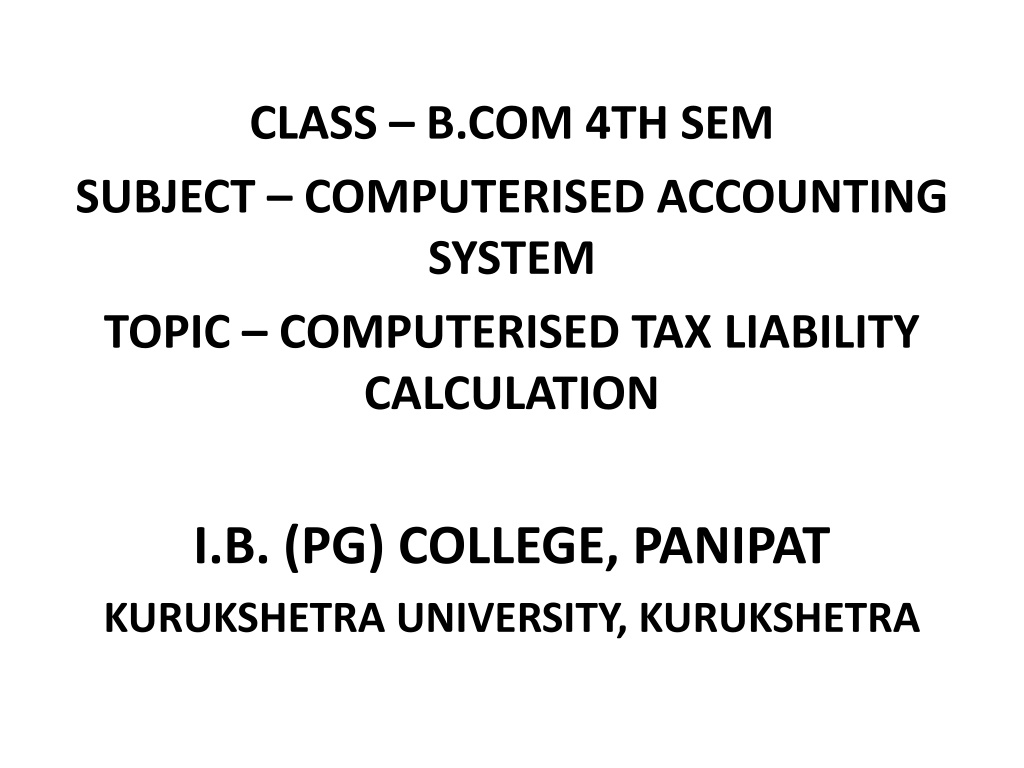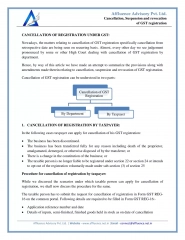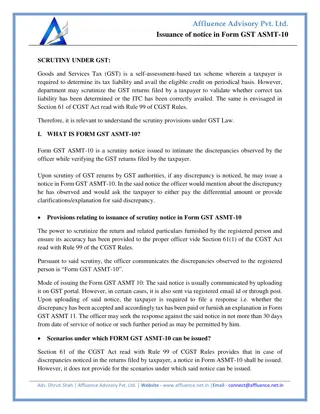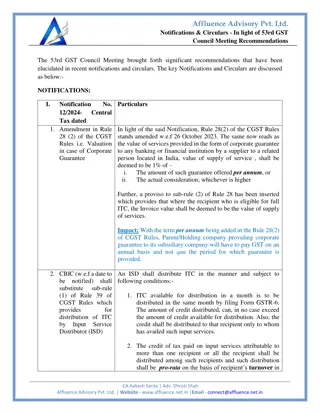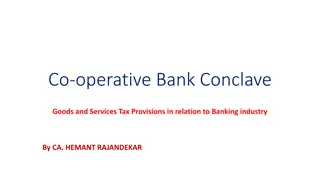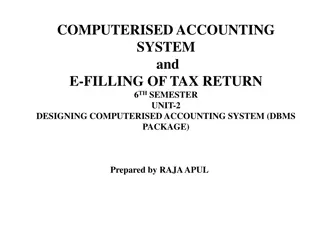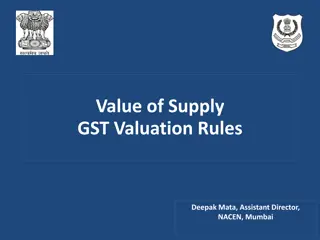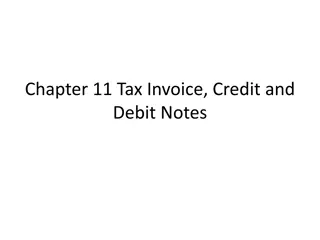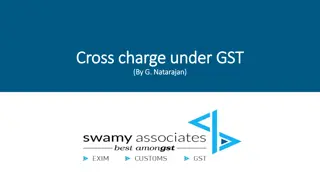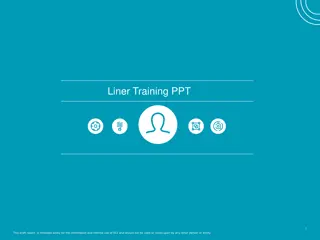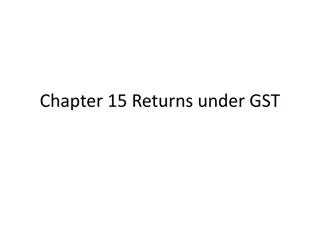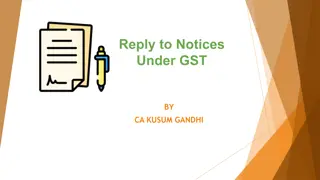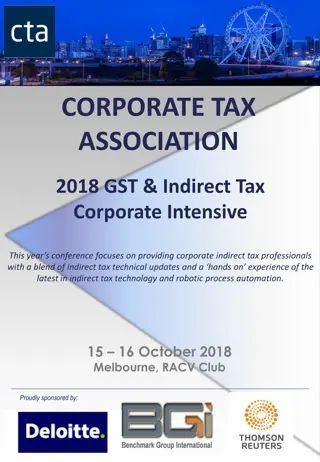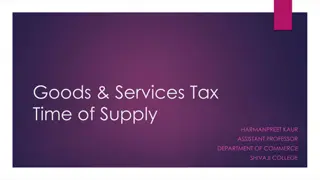Understanding Computerised Accounting System and GST in B.Com 4th Semester
Computerised Accounting System is a modern tool replacing manual accounting, facilitating easier processing of financial transactions and tax liabilities. Goods and Service Tax (GST) is an indirect tax introduced in India in 2017, simplifying tax structure. Various types of GST include IGST, CGST, SGST, and UTGST, each serving specific purposes. GST rates range from 0% to 28%, with different items falling under each slab.
Download Presentation

Please find below an Image/Link to download the presentation.
The content on the website is provided AS IS for your information and personal use only. It may not be sold, licensed, or shared on other websites without obtaining consent from the author. Download presentation by click this link. If you encounter any issues during the download, it is possible that the publisher has removed the file from their server.
E N D
Presentation Transcript
CLASS B.COM 4TH SEM SUBJECT COMPUTERISED ACCOUNTING SYSTEM TOPIC COMPUTERISED TAX LIABILITY CALCULATION I.B. (PG) COLLEGE, PANIPAT KURUKSHETRA UNIVERSITY, KURUKSHETRA
Computerized Accounting System Computerized Accounting System is a modern substitute for manual accounting. Accounting as a subject has become so complex that it cannot be handled easily with pen & paper format. The computerised accounting system is an accounting data system that processes the financial transactions and transactions as per GAAP (Generally Accepted Accounting Principles) to produce reports as per user demands. In a computerised accounting system, the structure of storage and processing of data is known as an operating environment that comprises of hardware as well as software in which the accounting system, works. Computerized Accounting makes it easy to file the GST returns as GST portal supports the exported excel files automatically. It saves a businessman from the hazards of going to an expert for getting the returns filed. Accounting and Taxation course is designed to impart the manual accounting, taxation, IT and computerised accounting skills to the learners.
Goods and Service Tax (GST) GST stands for Goods and Service Tax. GST is an indirect tax imposed on the supply of goods and services by the state and central government. It is a destination based single tax. The GST has been defined as a tax on supply of goods or services or both, except supply of alcoholic liquorfor human consumption and petroleum products . In India, the Goods and Service Tax (GST) came into force on 1stJuly 2017. It extends to the whole of India. GST is governed by 4 Central Acts and 29 state Acts. Most of the existing indirect taxes levied by the central and state governments have been subsumed in GST.
There are many types of GST: IGST CGST SGST UTGST
IGST- IGST means Integrated Goods and Service Tax imposed on interstate supply of goods orservices and on import of goods or services or both. CGST - CGST means Central goods and Services Tax; It is imposed on intra- state supply ofgoods or services or both. It is the portion of tax on intra state supply charged by Central Government. SGST SGST means State goods and Service Tax. SGST is imposed on intra-state supply ofgoods or services or both. . It is the portion of tax on intra state supply charged by State Government. UTGST- UTGST means Union Territory Goods and Service Tax, imposed on supply of goods orservices within a union territory. It is the portion of tax on intra state supply charged by a Union Territory Government
GST Rates: GST council recommended for a 5 slab tax rates for the supply of goods and services. The items falling under these slabs can be revised by GST council time to time. The present GST Rates are 0%, 5%, 12%, 18% and 28%. A list of GST rates and a few items falling under these rates are given below. 0% 5% 12% 18% 28% Buttermilk Dried fish Meat of bovine Malt, whether or Chewing gum animals not roasted Curd Crab meat Meat of goats Extracts, of neem Cocoa frozen butter,fat and oil Eggs Concentrated Meat & edible Margarine Chocolate & milk and cream offal of poultry (excluding liquid chocolate margarine) products Natural honey Milk and Butter Peanut butter Instant Coffee cream in
0% 5% 12% 18% 28% nuts Coffee Onion Raw cashew Glucose Custard powder Paints and varnishes Mustard flour, meal, prepared mustard Garlic Green tea Almond (in shell; dried) Guavas, mangoes and mangosteens dried Pasta Cauliflower Black pepper Vegetables, fruit, nuts and other edible parts of plants, prepared or preserved by vinegar or acetic Synthetic vinegar Mixed vegetables Chilly powder Dried grapes Smoking tobacco Green pepper Vanilla powder Wheat starch Instant tea Cement Coconut Groats and meal, of wheat (put up in unit container and bearing a registered brand name) Fish liver oils and their fractions Cashew nut, roasted, saltdd or roasted and salted Preparations for use on the hair such as shampoos, Hair Lacquers, Hair cream, hair dyes Dates Seeds of cumin Fruit juices Soya sauce Talcum
GST rates of services Service Rate of tax Transport of goods by rail 5% Transport of passengers by rail (other than sleeper class) 5% Services of goods transport agency in relation to 5% transportation of used household goods for personal use. Transport of passengers by air in economy class 5% Supply of tour operators services 5% Transport of passengers by air in other than economy class 12% Supply of Food/drinks in restaurant not having facility of 12% air-conditioning or central heating at any time during the year and not having licence to serve liquor. Services by way of admission or access to circus, Indian 18% classical dance including folk dance, theatrical performance, drama
Input Tax and Out Put Tax The taxable event under GST is Supply of goods or Services or both. Supply may be Inward supply and Outward supply. The GST paid on inward supply is called Input tax. In other words the GST on purchase of goods and services is known as Input Tax. Input tax shall be specifically named as Input IGST or Input CGST or Input SGST. The tax collected from outward supply of goods is called Output Tax. In other words the GST on sale of goods and services is known as Output Tax. The output tax may be specifically named as Output IGST/Output CGST/Output SGST Taxes Output CGST Output SGST Output IGST Input CGST X Input SGST X Input IGST
Identification of Debit and Credit aspects in GST regime The accounts to be debited and credited for business transactions with GST is explained in the following illustration Illustration 1 Identify the debit and credit aspects of the following transactions . Ramu started business with cash Rs. 22000 Purchased furniture for cash from Tamilnadu Rs. 7000, IGST 350 Sold goods on credit to Ravi Rs. 4000, CGST Rs.100 and SGST Rs.100 Received rent Rs.500 5.Paid insurance Rs. 750 Received cash from Ravi Rs.4200
Aspects Type of Increase/ Dr./Cr. Transactions 1. Started business Account Asset Decrease Increase 1.Cash Dr. with cash 2.Capital Capital Increase Cr. 2.Purchased furniture 1.Furniture Asset Increase Dr. 2 Input IGST Asset Increase Dr. 3.Cash 1.Ravi (Debtors) Asset Asset Decrease Increase Cr. Dr. 3.Goods sold to Ravi 2. Local Sales Income Increase Cr. 3.Out put CGST Liability Increase Cr. 4.Output SGST 1.Cash Liability Asset Increase Increase Cr. Dr. 4.Received rent 2.Rent Income Increase Cr. 5.Paid insurance 1.Insuranc Expense Increase Dr. premium 2.Cash Asset Decrease Cr. 6.Received cash from 1.Cash Asset Increase Dr. Ravi 2.Ravi (Debtors) Asset Decrease Cr.
Accounting Equation in GST regime Various Input and Output taxes affect basic accounting equation. Input taxes are considered as current assets and output taxes are considered as current liabilities. Let s examine the following illustration. Illustration I: Prepare a statement proving the accounting equation from the following transactions. Local purchase on credit from Global Furniture 40 Table @ Rs.2000, CGST-2. 5% & SGST-2.5% Bought machinery for Rs. 60,000 Purchased postal stamp for Rs. 200 Paid salary Rs.8000 Received commission Rs.7200(after deducting 10%TDS)
Illustration 2: Samudra Traders is a registered dealer at Kochi. Their transactions during the month of November 2017 are given below Nov 1. Purchased from Lulu mal Kochi, goods for cash worth Rs.80,000/- GST 12% 2. Credit purchases from Almas traders Aluva 5% GST goods worth Rs.1,00,000/- 4. Cash sales to Mr.Basith 12% GST goods for Rs.25000/- 5. Returned to Almas goods worth Rs.10000/- 6. Sold on credit to Anna traders Chennai,5% GST goods for Rs.60,000/- 9. Credit purchases from Gowda&co, Mysore,18%GST goods for Rs.140000/- 12. Sold for cheque goods worth Rs.40000/- GST12% 15. Bought 18% furniture from Nilambur furnitures for cash Rs.40000/- 18.Recieved goods returned by Anna Traders worth Rs.8000/- 20.Purchased Machinary fom Coimbatore for Rs.120000/- GST@12%,Paid by cheque
SAMUDRA TRADERS JOURNAL Date Particulars LF Debit Credit 2017Nov1 Local Purchase a/c Input CGST a/c Input SGST a/c Cash a/c Local Purchase a/c Input CGST a/c Input SGST a/c Almas traders a/c Cash a/c Local Sales a/c Output CGST a/c Output SGST A/C Almas traders a/c Local Purchase a/c Input CGST a/c Input SGST a/c 80000 4800 4800 89600 2 100000 2500 2500 125000 4 28000 25000 1500 1500 5 10500 10000 250 250 6 Anna traders a/c Interstate Sales a/c Output IGST a/c 63000 60000 3000 9 Interstate Purchase a/c Input IGST a/c Gowda&co, a/c 140000 25200 165200
SAMUDRA TRADERS JOURNAL 12 Bank a/c 44800 Local Sales a/c 40000 Output CGST a/c 2400 Output SGST A/C 2400 15 Furniture a/c 40000 Input CGST a/c 3600 Input SGST a/c 3600 Cash a/c 47600 18 Interstate Sales a/c 8000 Output IGST a/c 400 Anna traders a/c 8400 20 Machinery a/c 120000 Input IGST a/c 14400 Bank a/c 134400
THANK THANK YOU YOU
